Ballistic Protection Market Size
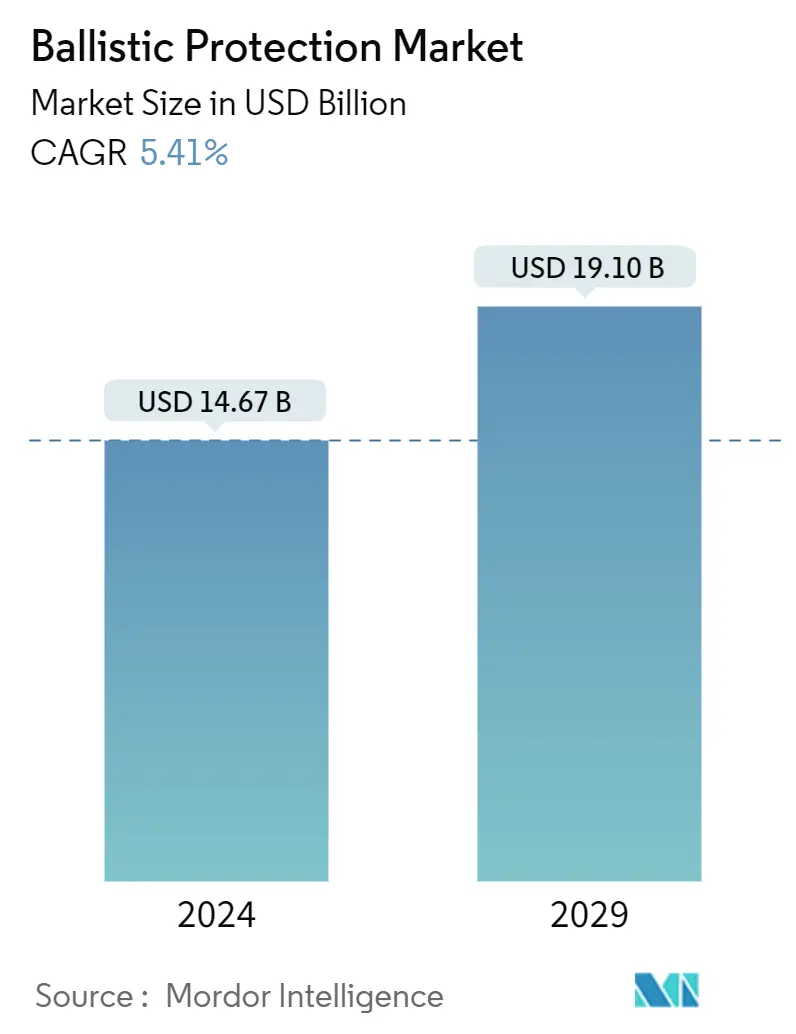
| Study Period | 2019 - 2029 |
| Market Size (2024) | USD 14.67 Billion |
| Market Size (2029) | USD 19.10 Billion |
| CAGR (2024 - 2029) | 5.41 % |
| Fastest Growing Market | Asia Pacific |
| Largest Market | North America |
Major Players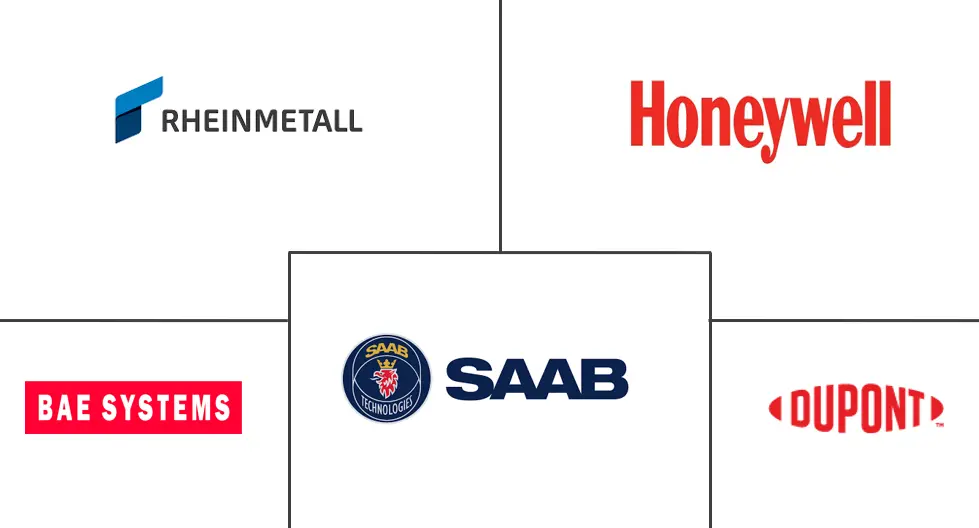
*Disclaimer: Major Players sorted in no particular order |
Ballistic Protection Market Analysis
The Ballistic Protection Market size is estimated at USD 14.67 billion in 2024, and is expected to reach USD 19.10 billion by 2029, growing at a CAGR of 5.41% during the forecast period (2024-2029).
- The COVID-19 pandemic negatively impacted the ballistic protection market. The onset of the pandemic led various governments around the world to impose regulations and lockdowns to curb the spread of the pandemic. This led to a decline in the free flow of trade as well as delays in terms of raw materials being received by manufacturers of ballistic protection systems which led to delays in terms of production and deliveries of ballistic protection systems. Moreover, the onset of the pandemic also led to layoffs by various companies, which led to a decline in the production of ballistic systems. On the other hand, the decline of COVID-19 severity led to various countries around the world opening up their restrictions and barriers to trade, which has led to gradual growth in effective trade between countries.
- The ongoing political turmoil across several regions, coupled with the widening geopolitical rift leading to an accumulation of weapons and ammunition by nations to safeguard against threats is also driving the demand for ballistic protection equipment.
- However, factors such as the inaccuracy of protection level, the high production cost of armor materials, and the occurrence of mechanical failure restrain the growth of the market.
- Nevertheless, factors such as growth in demand for multipurpose ballistic protection equipment and a rise in demand for lightweight body armor create lucrative opportunities for key players in the ballistic protection market.
Ballistic Protection Market Trends
Vehicle Protection Equipment Segment Is Expected to Witness Significant Growth During the Forecast Period
- By product type, the vehicle protection equipment segment is expected to witness significant growth during the forecast period. Growth in terms of defense expenditure of various countries coupled with growing military modernization processes are the major factors that will contribute to the growth of the market during the forecast period.
- According to the Stockholm International Peace Research Institute (SIPRI), global defense spending grew for the eighth consecutive year and reached USD 2.24 trillion in 2022. In addition, various governments around the world are now investing in terms of advanced vehicle ballistic protection systems for defense vehicles, and this has encouraged manufacturers to develop advanced vehicle protection systems in order to comply with the requirements and needs of the customers.
- Ballistic protection is crucial for the survivability of military vehicles and the personnel inside the vehicles. A variety of materials, including lightweight and composite materials, are used to provide enhanced protection. Ballistic protection solutions safeguard armored vehicles used by the global armed forces against a plethora of threats, including munitions, anti-tank grenade launchers (ATGLs), improvised explosive devices (IEDs), guided missiles, frag grenades, and mines.
- Various materials comprising aluminum, steel, glass, plastic, uranium, and composite are being used in the manufacturing of vehicle protection equipment. Furthermore, solutions can also be customized to meet the different mission requirements. The equipment can be integrated into the vehicle structure during manufacturing or during the retrofit stage.
- The changing battlefield scenario has prompted the increasing development of high-tech systems to protect armored vehicles completely and effectively by tailoring the systems to provide protection in specific operations. Various companies, such as Aurum Security GmbH, RUAG Group, as well as DuPont, and Honeywell, are now engaged in the development of comprehensive solutions to protect against large-caliber munitions, anti-tank grenade launchers, guided missiles, improvised explosive devices, and mines, amongst others. For instance, in June 2022, General Dynamics European Land Systems (GDELS) announced that they had premiered their new Pandur 6*6 Evo-wheeled armored vehicle. The vehicle, which has already been selected by the Austrian army, provides high survivability and crew protection against ballistic, mine, IED blast, and fragmentation threats.
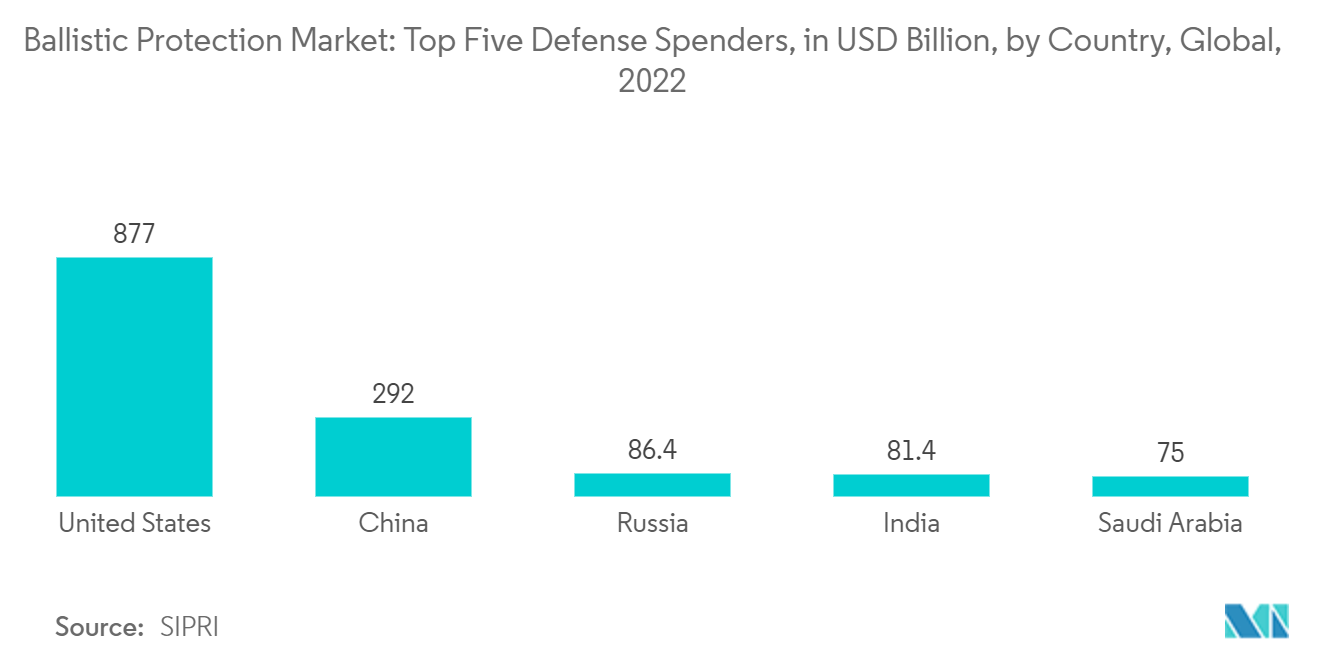
North America to Dominate the Market During the Forecast Period
- The increase in the defense budget, coupled with military modernization programs and the need for advanced protection systems, have contributed to the growth of the market in North America during the forecast period. According to SIPRI, the United States of America spent USD 877 billion in 2022 on its defense operations. Firearms are one of the most dangerous threats faced by law enforcement officers in the United States.
- During the past three decades, ballistic-resistant soft body armor has saved the lives of more than 3,000 police officers. Body armor is critical safety equipment that law enforcement and corrections officers need for personal protection. The National Institute of Justice, which is a research, development, and evaluation agency of the United States Department of Justice, establishes and updates voluntary minimum performance standards for body armor as well as conducts tests to ensure that body armor complies with the standards that have been set out in the country.
- DuPont and Honeywell are among the companies in the United States actively involved in developing advanced ballistic protection systems. DuPont is focused on providing protection solutions that meet the specific needs of military personnel, law enforcement officers, and emergency responders.
- In October 2021, DuPont introduced its new Core Matrix Technology that combines numerous woven layers by infusing staple fiber in the z-direction, which is perpendicular to the ground plane. This hybrid structure is extremely soft and flexible and increases the overall ballistic performance for bullet threats and fragmentation protection.
- The technology helps in delivering the most advanced ballistic protection that is required by the military, law enforcement, and global security officers while increasing flexibility and comfort. In addition, in February 2021, DuPont announced that they had acquired the technology from Tex Tech. Thus, such advancements will lead to the market witnessing growth during the forecast period.
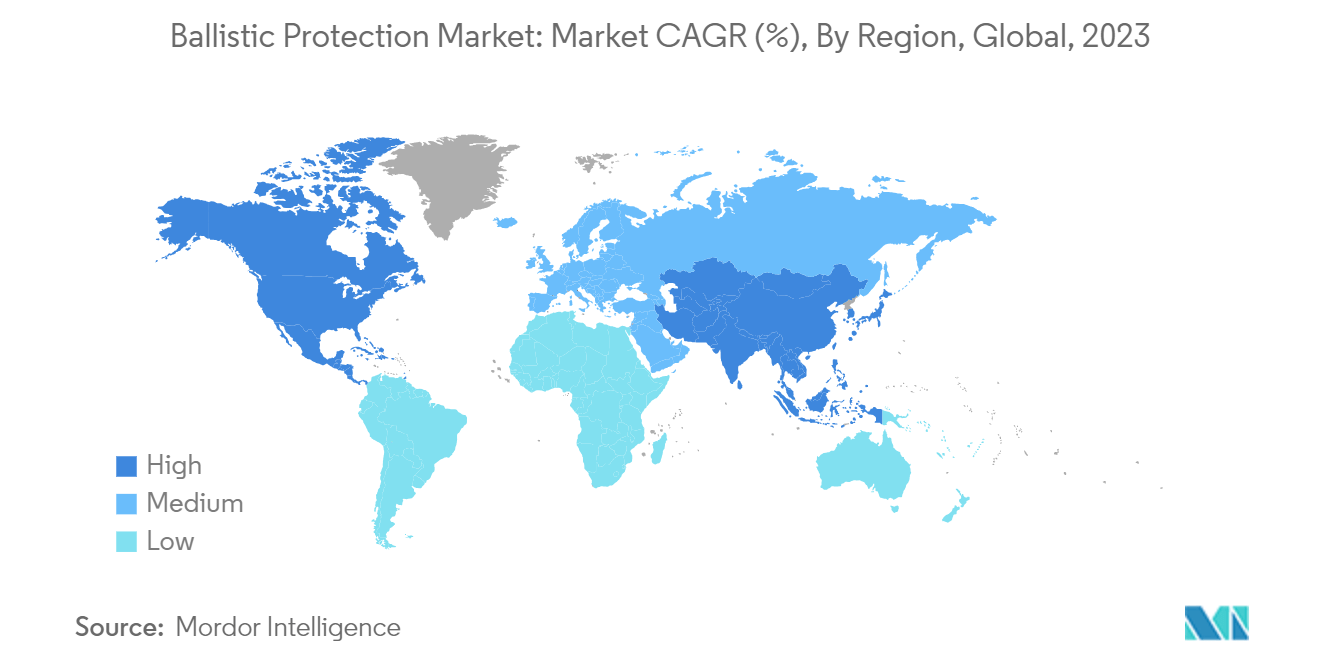
Ballistic Protection Industry Overview
The ballistic protection market is semi-consolidated in nature due to the presence of several local and global players holding significant shares in the market. Some of the prominent players in the ballistic protection market are BAE Systems plc, DuPont, Honeywell International Inc., Rheinmetall AG, and Saab AB, amongst others. These companies deploy both organic and inorganic strategies to consolidate their market positioning. The key players highly invest in enhancing soldiers' security and thus focus on developing advanced solutions for defense forces.
Moreover, as the market demand improves with the growth in terms of defense budgets of various nations coupled with military modernization being a priority of various countries worldwide, it is expected that the smaller players will be acquired to gain a competitive advantage in the future.
Ballistic Protection Market Leaders
-
Saab AB
-
BAE Systems plc
-
Honeywell International Inc.
-
Rheinmetall AG
-
DuPont
*Disclaimer: Major Players sorted in no particular order
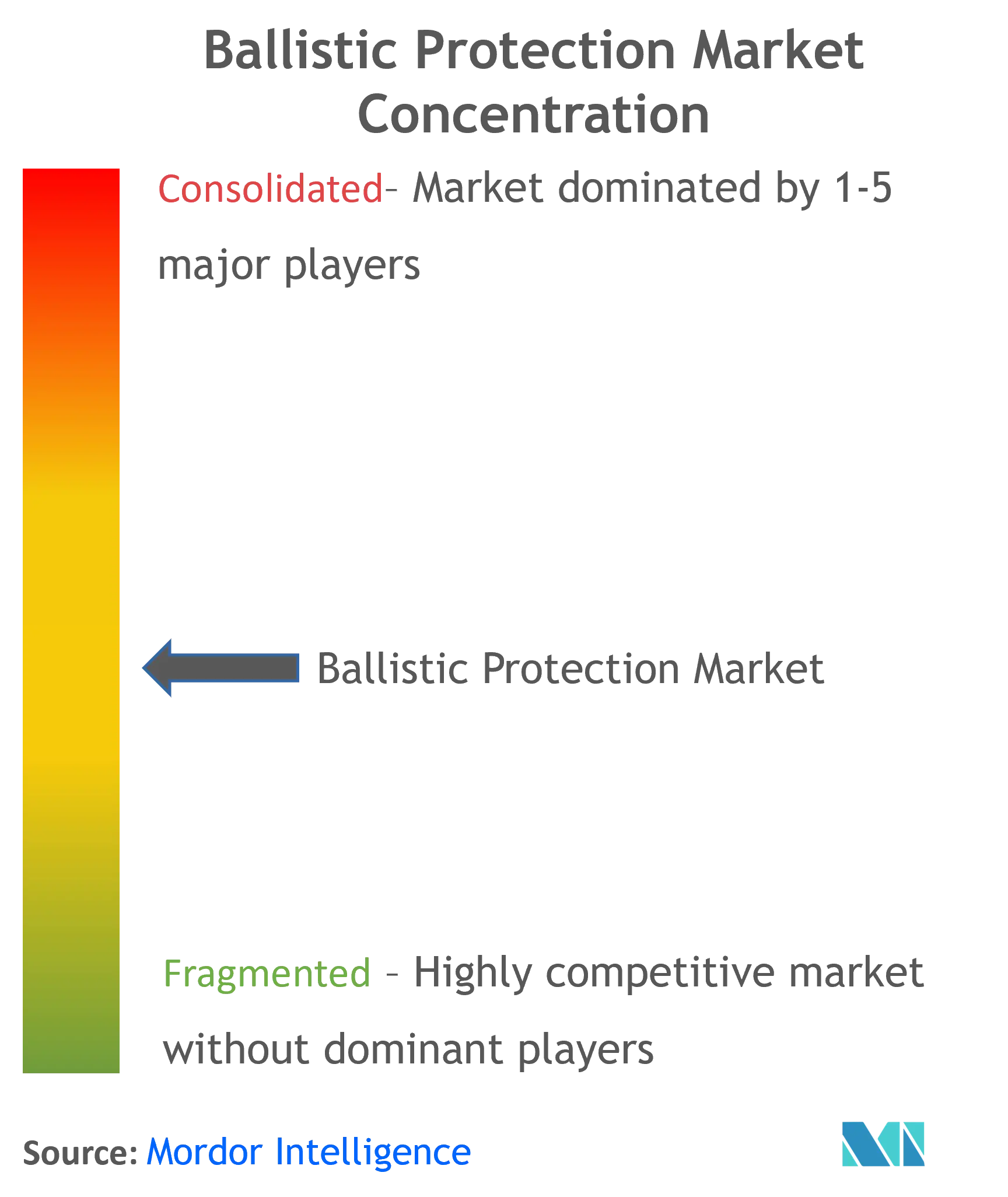
Ballistic Protection Market News
- October 2023: Dyneema, a part of Avient Corporation, a leading provider of specialty and sustainable material solutions, launched a next-generation unidirectional (UD) material innovation based on its third-generation fiber named Dyneema SB301. This material is envisioned to enable body armor manufacturers to design soft armor vests 10–20% lighter than previous protective solutions.
- December 2022: Nova Graphene Ballistics made an announcement regarding its restructuring and reconstitution as a marketer and seller of graphene products. Previously known as Premier Biomedical Inc., the company revealed agreements to manufacture its revolutionary 3D-printed ballistic armor, utilizing its proprietary graphene production methodology.
- October 2022: The European Defence Agency (EDA) disclosed the launch of a project aimed at utilizing new advancements in metallic materials for ballistic steels. The project's objective is to enhance the performance of ballistic and blast protection by incorporating auxetic structures, which become thicker when stretched or thinner when compressed.
Ballistic Protection Market Report - Table of Contents
1. INTRODUCTION
- 1.1 Study Assumptions
- 1.2 Scope of the Study
2. RESEARCH METHODOLOGY
3. EXECUTIVE SUMMARY
4. MARKET DYNAMICS
- 4.1 Market Overview
- 4.2 Market Drivers
- 4.3 Market Restraints
-
4.4 Industry Attractiveness - Porter's Five Forces Analysis
- 4.4.1 Threat of New Entrants
- 4.4.2 Bargaining Power of Buyers/Consumers
- 4.4.3 Bargaining Power of Suppliers
- 4.4.4 Threat of Substitute Products
- 4.4.5 Intensity of Competitive Rivalry
5. MARKET SEGMENTATION
-
5.1 Product Type
- 5.1.1 Personal Protection Equipment
- 5.1.2 Vehicle Protection Equipment
-
5.2 Application
- 5.2.1 Terrestrial
- 5.2.2 Airborne
- 5.2.3 Marine
-
5.3 Technology
- 5.3.1 Soft Armor
- 5.3.2 Hard Armor
-
5.4 Geography
- 5.4.1 North America
- 5.4.1.1 United States
- 5.4.1.2 Canada
- 5.4.2 Europe
- 5.4.2.1 United Kingdom
- 5.4.2.2 France
- 5.4.2.3 Germany
- 5.4.2.4 Russia
- 5.4.2.5 Rest of Europe
- 5.4.3 Asia-Pacific
- 5.4.3.1 China
- 5.4.3.2 India
- 5.4.3.3 Japan
- 5.4.3.4 South Korea
- 5.4.3.5 Rest of Asia-Pacific
- 5.4.4 Latin America
- 5.4.4.1 Brazil
- 5.4.4.2 Mexico
- 5.4.4.3 Rest of Latin America
- 5.4.5 Middle East and Africa
- 5.4.5.1 Saudi Arabia
- 5.4.5.2 United Arab Emirates
- 5.4.5.3 Rest of Middle East and Africa
6. COMPETITIVE LANDSCAPE
- 6.1 Vendor Market Share
-
6.2 Company Profiles
- 6.2.1 Avon Polymer Products Limited
- 6.2.2 BAE Systems plc
- 6.2.3 DuPont
- 6.2.4 Gentex Corporation
- 6.2.5 Honeywell International, Inc.
- 6.2.6 Point Blank Enterprises, Inc.
- 6.2.7 Rheinmetall AG
- 6.2.8 Saab AB
- 6.2.9 Survitec Group Limited
- 6.2.10 TenCate Advanced Armor USA, Inc.
- *List Not Exhaustive
7. MARKET OPPORTUNITIES AND FUTURE TRENDS
** Subject To AvailablityBallistic Protection Industry Segmentation
Ballistic protection equipment safeguards the human body and vehicles against bullets and missiles of various sizes, shapes, and impact velocities. This protection is usually required for general security personnel, soldiers, policemen, marine ships, military, and airborne vehicles. Many types of equipment of ballistic protection equipment are used for penetrating and non-penetrating impacts. Moreover, there are various levels of ballistic protection available in the market, with level 7 being considered the highest level in terms of ballistic protection.
The ballistic protection market has been segmented by product type, application type, technology type, and geography. By product type, the market has been segmented into personal protection equipment and vehicle protection equipment. By application type, the market has been segmented into military, airborne, and marine. By technology type, the market has been segmented into soft armor and hard armor. The report also covers the market sizes and forecasts for the ballistic protection market in major countries across different regions. For each segment, the market size is provided in terms of value (USD).
| Product Type | Personal Protection Equipment | |
| Vehicle Protection Equipment | ||
| Application | Terrestrial | |
| Airborne | ||
| Marine | ||
| Technology | Soft Armor | |
| Hard Armor | ||
| Geography | North America | United States |
| Canada | ||
| Geography | Europe | United Kingdom |
| France | ||
| Germany | ||
| Russia | ||
| Rest of Europe | ||
| Geography | Asia-Pacific | China |
| India | ||
| Japan | ||
| South Korea | ||
| Rest of Asia-Pacific | ||
| Geography | Latin America | Brazil |
| Mexico | ||
| Rest of Latin America | ||
| Geography | Middle East and Africa | Saudi Arabia |
| United Arab Emirates | ||
| Rest of Middle East and Africa |
Ballistic Protection Market Research Faqs
How big is the Ballistic Protection Market?
The Ballistic Protection Market size is expected to reach USD 14.67 billion in 2024 and grow at a CAGR of 5.41% to reach USD 19.10 billion by 2029.
What is the current Ballistic Protection Market size?
In 2024, the Ballistic Protection Market size is expected to reach USD 14.67 billion.
Who are the key players in Ballistic Protection Market?
Saab AB, BAE Systems plc, Honeywell International Inc., Rheinmetall AG and DuPont are the major companies operating in the Ballistic Protection Market.
Which is the fastest growing region in Ballistic Protection Market?
Asia Pacific is estimated to grow at the highest CAGR over the forecast period (2024-2029).
Which region has the biggest share in Ballistic Protection Market?
In 2024, the North America accounts for the largest market share in Ballistic Protection Market.
What years does this Ballistic Protection Market cover, and what was the market size in 2023?
In 2023, the Ballistic Protection Market size was estimated at USD 13.88 billion. The report covers the Ballistic Protection Market historical market size for years: 2019, 2020, 2021, 2022 and 2023. The report also forecasts the Ballistic Protection Market size for years: 2024, 2025, 2026, 2027, 2028 and 2029.
Ballistic Protection Industry Report
Statistics for the 2024 Ballistic Protection market share, size and revenue growth rate, created by Mordor Intelligence™ Industry Reports. Ballistic Protection analysis includes a market forecast outlook to for 2024 to (2024to2029 and historical overview. Get a sample of this industry analysis as a free report PDF download.



